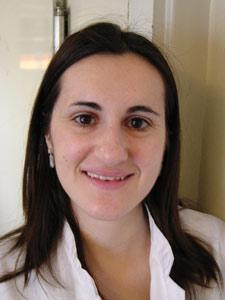Group at Institute for Cancer Research identifies new functional mechanism for a tumour suppressor

PhD student Antonia Sagona and her co-workers in Harald Stenmark´s group at the Centre for Cancer Biomedicine, Institute for Cancer Research, have uncovered a new functional mechanism for a known tumour suppressor, the class III phosphatidylinositol 3-kinase (PI3K-III), a protein complex that mediates formation of the membrane lipid, phosphatidylinositol 3-phosphate (PtdIns3P). The findings are published as a main article in the April 2010 issue of Nature Cell Biology (impact factor 17.774) .
New: The Nature staff has dedicated an extensive "News and Views" article to findings in this paper.
Sagona and her co-workers noticed that PtdIns3P is found at the midbody, the membrane bridge between two dividing cells, and they found that PI3K-III and PtdIns3P are required for proper cytokinesis, the final stage of cell division. The researchers went on to identify a PtdIns3P-binding protein, FYVE-CENT, as a key regulator of cytokinesis, and they found that FYVE-CENT translocates from the centrosome to the midbody during cytokinesis, powered by KIF13A, a motor protein that transports cargo along microtubules. Further, FYVE-CENT brings with it a smaller protein, TTC19, which interacts directly with CHMP4B, a component of the machinery that mediates the final abscission between two dividing cells (see Figure). Depletion of PI3K-III, FYVE-CENT or its interacting proteins causes cytokinesis arrest and an increased proportion of bi- and multinuclear cells.
"We are excited about these new results", says Harald Stenmark, "since they shed light on the tumour suppressor activity of PI3K-III and suggest a connection between faulty cytokinesis, formation of multinuclear cells, and cancer. This project also illustrates the benefit of the interdisciplinary collaborations that we have established within the Centre for Cancer Biomedicine, and includes scientists from cell biology as well as from translational cancer research and biostatistics. FYVE-CENT is frequently mutated in cancers, and further work in our Centre will reveal whether the PI3K-III/FYVE-CENT axis can be targeted for early diagnosis of cancer".
Links
PtdIns(3)P controls cytokinesis through KIF13A-mediated recruitment of FYVE-CENT to the midbody
Antonia P. Sagona, Ioannis P. Nezis, Nina Marie Pedersen, Knut Liestøl, John Poulton, Tor Erik Rusten, Rolf I. Skotheim, Camilla Raiborg & Harald Stenmark
Nature Cell Biology
Published online: 7 March 2010
News and Views article:
Nature Cell Biology 12, 308 - 310 (2010)
Abscission accomplished by PtdIns(3)P
By Guillaume Montagnac & Philippe Chavrier
Homepage Harald Stenmark's group - Intracellular communications
Department of Biochemistry
Insitute for Cancer Research
Centre for Cancer Biomedicine
